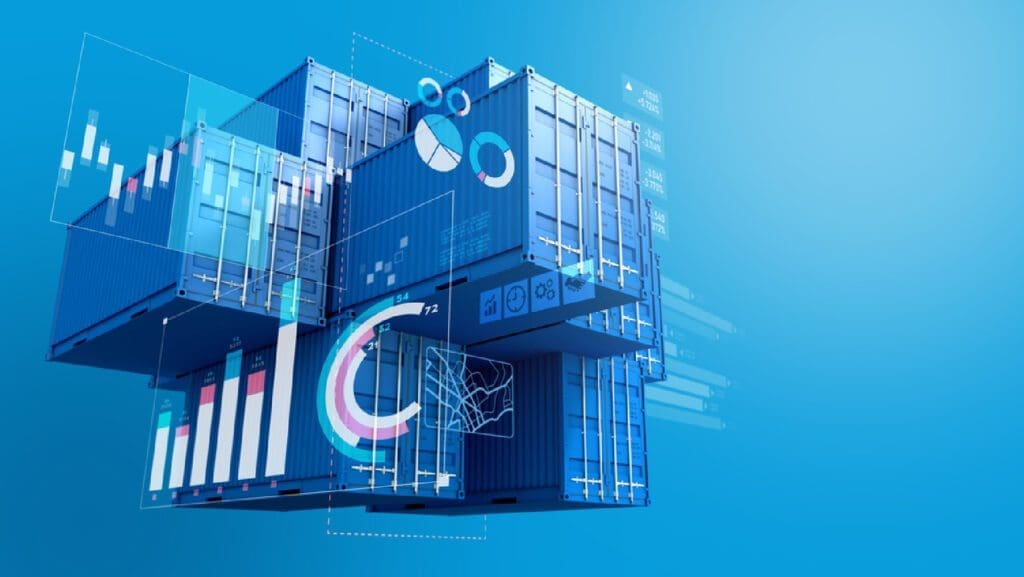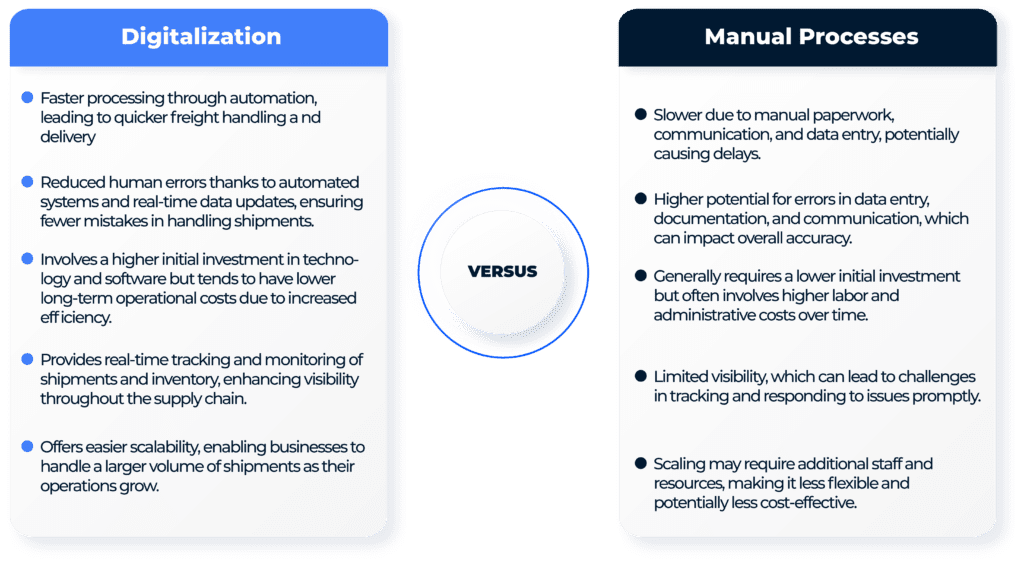
Published 2021
In today’s fast-paced global economy, freight forwarding is undergoing a profound transformation, ushered in by the rise of digital freight forwarders. The term “digital freight forwarder” has quickly become a buzzword in the logistics industry, signifying a fundamental shift in how forwarders engage with their clients, partners, and operations. These digital forwarders have harnessed the power of technology to offer a wide range of services, including instant quoting, online booking, shipment tracking, payments management, and robust dashboards. In this comprehensive exploration, we will delve deep into the world of digital freight forwarding, examining its impact, success stories, and the critical strategies involved in making this digital leap.
The Rise of Digital Freight Forwarders

Digitalization has become the lifeblood of modern business operations, and the freight forwarding industry is no exception. To survive and thrive in today’s digitally-led world, freight forwarders must maintain a robust online presence. The term “digital freight forwarder” encapsulates a new breed of logistics professionals who have embraced digital technologies to revolutionize their industry.
In the past, freight forwarders played a pivotal role in coordinating cargo movement, relying on carrier services to transport goods efficiently. However, the emergence of digitization has fundamentally altered this relationship by facilitating real-time data exchange between forwarders and carriers. This data exchange is essential for optimizing internal processes, enhancing customer experiences, and driving operational excellence.
Success Stories: Flexport and Beyond

One of the standout success stories in the digital freight forwarding revolution is the remarkable ascent of Flexport. Founded in 2013, Flexport has defied industry norms and risen to an extraordinary net worth of $3.2 billion. It now stands as one of the most valuable and innovative freight forwarders globally, surpassing the valuations of many long-established legacy companies in the field. Flexport’s success is not merely a result of offering a shiny client-facing online platform; it is a testament to the power of digital transformation in redefining the logistics landscape.
The Digital Transformation Challenge
While creating a visually appealing online platform is undoubtedly an essential aspect of becoming a digital freight forwarder, it’s far from the most challenging part of this transformation journey. At the heart of this transformation lies a fundamental goal: to enhance competitiveness by providing faster, more transparent, and accessible logistics services that operate around the clock.
This challenge extends beyond the external-facing platform; it requires a complete reimagining of internal processes. To truly leverage the potential of digitalization, forwarders must rebuild their operations around online services. For instance, seamless integration between carriers or platforms and the online portal is essential for instant tracking data, booking requests, and shipping instructions. Furthermore, for forwarders offering rates online, avoiding generic responses like “Thanks for your inquiry; we will revert soon” is paramount.
Rebuilding Internal Processes for the Digital Era
Becoming a digital freight forwarder necessitates a comprehensive overhaul of internal processes to align with online services. For instance, seamless integration between carriers or platforms and the online portal is essential for instant tracking data, booking requests, and shipping instructions. Furthermore, for forwarders offering rates online, avoiding generic responses like “Thanks for your inquiry; we will revert soon” is paramount.
The Role of Client-Facing Online Platforms
To truly add value for shippers and consignees, an online portal must deliver on its promises. Otherwise, forwarders risk the persistent complaint that customers prefer personal interactions over technology. We will examine the critical elements that make a client-facing online platform successful, including usability, functionality, and real-time responsiveness.
The Significance of User Adoption
The willingness of customers to embrace online portals can be a telling indicator of their usability and functionality. If clients continue to rely on phone calls despite the availability of digital solutions, it often signals that the online platform falls short in various ways. We will delve into the importance of user adoption and how forwarders can bridge the gap between technology and customer satisfaction.
Opportunities Unveiled by Carrier Digitization
Enhanced Customer Experience: The ability to offer real-time tracking, accurate pricing, and streamlined booking processes enhances the overall customer experience. Forwarders can provide clients with up-to-date information, enabling them to make informed decisions and anticipate potential disruptions.
Operational Efficiency: Digitization optimizes processes, reducing manual intervention and improving efficiency. This leads to quicker turnaround times, better resource utilization, and cost savings.

Data-Driven Insights: The influx of real-time data allows forwarders to gain valuable insights into shipment patterns, transit times, and potential bottlenecks. This information can be leveraged for predictive analytics and proactive issue resolution.
Collaborative Innovation: Forwarders and carriers can collaborate on technological innovations, such as blockchain applications for supply chain transparency and security, creating win-win scenarios that benefit both parties.
Navigating the Potential Challenges
Overdependence on Carriers: While the digitization wave presents significant benefits, forwarders could become overly reliant on carriers’ digital offerings. This reliance could pose a challenge if carriers alter their strategies or new competitive dynamics emerge.
Security Concerns: As data exchange becomes more extensive, concerns about data security and cyber threats grow. Forwarders need to ensure robust cybersecurity measures to protect sensitive information.
Skill Upgradation: The adoption of digital tools requires upskilling the workforce to effectively navigate these technologies. Investing in training is crucial to maximizing the benefits of digitization.
The Path Forward: Collaboration and Adaptation
To capitalize on the opportunities presented by carrier digitization while mitigating potential challenges, forwarders need to adopt a strategic approach:
Embrace Integration: Fully embrace the integration of carrier data into operations. Utilize standardized formats to simplify integration efforts and reduce maintenance complexities.
Diversify Digital Offerings: Develop proprietary digital platforms that complement carriers’ services, offering customers added value beyond basic services.
Continuous Innovation: Foster a culture of innovation by investing in research and development. Explore emerging technologies such as artificial intelligence and the Internet of Things to stay competitive.
Customer-Centric Approach: Keep the customer at the center of all digital endeavors. Develop tools and services that align with customers’ evolving expectations.
In Conclusion: The Digital Transformation Imperative
The transformation into a digital freight forwarder is more than just a technology change; it’s a shift in mindset and strategy. The success of digital forwarders lies in their ability to harness technology to meet customer demands, streamline operations, and drive innovation. In this era of digitalization, the journey of becoming a digital freight forwarder is not just about survival; it’s about thriving and leading the way in an industry poised for a digital revolution. Join us on this transformative journey as we unravel the intricate world of digital freight forwarding and discover the key strategies for success in the modern logistics landscape.

